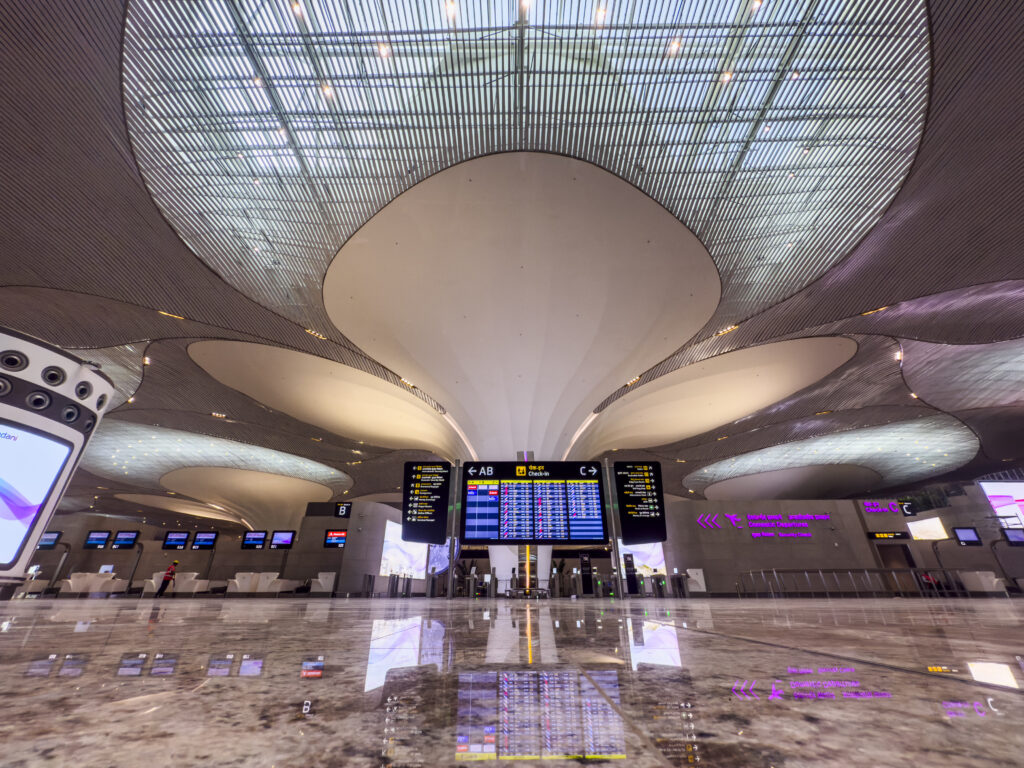The new Navi Mumbai International Airport (NMIA) terminal, designed by Zaha Hadid Architects (ZHA), is being praised for its futuristic design and bold structural approach. With lotus-inspired geometry, dual-column systems, and carefully planned daylighting, the terminal combines cultural symbolism with high-performance engineering. The design addresses challenges such as heavy monsoons, seismic risks, and increasing air traffic.

ZHA’s Largest Indian Project
Awarded after an international competition in 2018, NMIA is ZHA’s most significant project in India and among its largest airport ventures globally. The London-based firm, known for fluid, parametric architectural forms, applies its expertise to India’s dense urban and climatic context, designing Terminal 1, the ATC tower, and supporting landside infrastructure.
Lotus-Inspired Design
Rather than using the lotus as decoration, ZHA translated its form into the terminal’s geometry. The roof unfolds in concentric, petal-like shells that guide movement and optimize environmental performance. Each canopy segment manages daylight, wind, and monsoon drainage, while the central atrium acts as the symbolic “pond” from which concourses radiate. This approach blends national symbolism with structural efficiency.
Precision Engineering and Modular Fabrication
Each roof petal was digitally modeled and fabricated in modular steel units. On-site assembly involved laser-guided alignment and high-tolerance joints to ensure continuity. The roof combines reinforced concrete cores, steel superframes, and tensile cladding designed to handle thermal expansion and strong monsoon winds, achieving a seamless balance between sculptural form and engineering performance.
Two-Tier Column System
NMIA’s interior rhythm is defined by a two-tier column structure. Twelve hollow feature columns at the front resemble unfurling petals, diffusing daylight and providing intuitive orientation. Behind them, seventeen mega-columns carry the roof’s structural loads, resisting wind and seismic forces. This separation of visible and technical functions creates the illusion of a weightless roof while maintaining stability.
Modern Architecture Rooted in Tradition
The terminal’s spatial language draws from Indian architectural heritage. Columned halls recall temple mandapas, and axial layouts echo historic civic and sacred interiors. By combining tradition with modern materials like steel and glass, NMIA merges local cultural identity with a contemporary global design language.
Daylight as a Design Element
Natural light is integral to NMIA’s experience. Skylight strips in the roof petals, along with hollow feature columns, channel sunlight deep into the concourse. This reduces reliance on artificial lighting while creating a dynamic interplay of light and shadow, enhancing the passenger experience.
Modular and Expandable
NMIA is designed as a modular system for phased growth. Phase 1 handles 20 million passengers annually, with capacity expandable to 90 million as new terminals and a second runway are added. The 1,160-hectare site between Panvel Creek and Ulwe River allows each module to be added without disrupting operations, ensuring the airport adapts to Mumbai’s evolving aviation needs.
